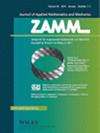热辐射动力学和洛伦兹力对混合纳米流体(乙二醇+石墨烯+铜)流动的化学反应的指数拉伸片:不可逆性分析
IF 3.2
4区 工程技术
Q1 MATHEMATICS, APPLIED
Zamm-zeitschrift Fur Angewandte Mathematik Und Mechanik
Pub Date : 2023-10-18
DOI:10.1002/zamm.202300130
引用次数: 0
摘要
纳米流体是一种令人兴奋的新型传热流体,已成为传统流体的替代品。燃料电池、热交换器和制药过程只是它们众多用途中的一小部分。与单流体相比,混合流体的传热性能优越。这些发现广泛应用于从太阳能到空调等各个领域。本文的目的是研究洛伦兹力和化学反应参数如何影响一对应力混合纳米流体(乙二醇+石墨烯+铜)通过指数拉伸表面的流动特性。利用粘性耗散、指数热源和热辐射参数研究了热传导现象。此外,本文还进行了不可逆性分析。采用适当的相似变换将控制方程转化为一组非线性常微分方程。利用MATLAB中的bvp4c求解器对变换后的系统进行求解。感兴趣的工程参数,包括表面摩擦系数,用条形图来描述。已经注意到,磁场和石墨烯纳米颗粒的体积分数(φ 1)降低了表面摩擦系数。在时,表面摩擦系数以4.68187的速率减小。观察到,随着指数热源参数的增大,流体温度增大,速度剖面随着混合对流参数的增大而增大。可以发现,当Eckert数()设置为时,Nusselt数减少了6.29239。可以注意到,当化学反应()设为时,传质速率以0.349644的速率上升。已经观察到,随着布林克曼数和磁场参数的增加,熵的产生率也随之增加。还发现,随着孔隙度参数的增大,流体动量减小。此外,增大耦合应力参数会降低流体速度。本文章由计算机程序翻译,如有差异,请以英文原文为准。
Dynamics of thermal radiation and Lorentz force on the hybrid nanofluid (Ethylene Glycol + Graphene + Copper) flow via an exponentially stretching sheet with chemical reaction: An irreversibility analysis
Abstract An exciting new class of heat transmission fluids, nanofluids, has been developed as an alternative to traditional fluids in manufacturing. Fuel cells, heat exchangers and pharmaceutical processes are just a few of the many uses for them. When compared to monofluids, the heat transmission properties of hybrid fluids are superior. These are findings used in an extensive diversity of fields, from solar energy to air conditioning. The objective of this paper is to examine how Lorentz force and chemical reaction parameters affect the characteristics of a couple stress hybrid nanofluid (Ethylene Glycol + Graphene + Copper) flow via an exponentially stretching surface. The heat transport phenomenon is studied using viscous dissipation, exponential heat source and thermal radiation parameters. Furthermore, irreversibility analysis is provided in this paper. Governing equations are transformed into a set of nonlinear ordinary differential equations using suitable similarity transformations. The bvp4c solver in MATLAB is used to solve the transformed system. Engineering parameters of interest, including skin friction coefficient, are described using bar diagrams. It has been noted that the magnetic field and volume fraction of graphene nanoparticles (ϕ 1 ) reduce the skin friction coefficient. At , the skin friction coefficient decreases at a rate of 4.68187. It is observed that there is an increment in the fluid temperature with the rise in the exponential heat source parameter, and the velocity profile increases with the increase in the mixed convection parameter. It is detected that, while Eckert number () was set to , Nusselt number was reduced by 6.29239. It is noticed that, while the chemical reaction () is set to , the mass transfer rate rises at a Rate of 0.349644. It has been observed that as the Brinkmann number and magnetic field parameters increase, so does the rate of entropy production. It is also detected that as the porosity parameter increases, the fluid momentum decreases. Furthermore, increasing the couple stress parameter decreases the fluid velocity.
求助全文
通过发布文献求助,成功后即可免费获取论文全文。
去求助
来源期刊
CiteScore
3.30
自引率
8.70%
发文量
199
审稿时长
3.0 months
期刊介绍:
ZAMM is one of the oldest journals in the field of applied mathematics and mechanics and is read by scientists all over the world. The aim and scope of ZAMM is the publication of new results and review articles and information on applied mathematics (mainly numerical mathematics and various applications of analysis, in particular numerical aspects of differential and integral equations), on the entire field of theoretical and applied mechanics (solid mechanics, fluid mechanics, thermodynamics). ZAMM is also open to essential contributions on mathematics in industrial applications.

 求助内容:
求助内容: 应助结果提醒方式:
应助结果提醒方式:


